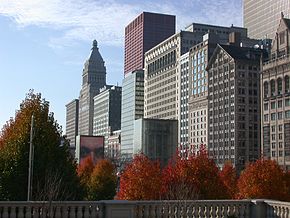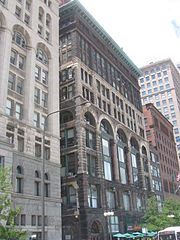- Historic Michigan Boulevard District
-
Historic Michigan Boulevard District Michigan Avenue 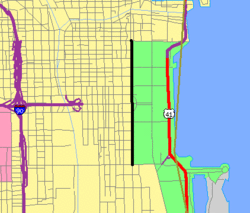
Maintained by: Department of Streets & Sanitation Location: Chicago North end: 150 North at Randolph Street Major
junctions:Monroe Street/Drive
Jackson Blvd./Drive US 66
US 66
Congress Pkwy./Dr.
from/to Eisenhower Expressway I-290
I-290
Balbo DriveSouth end: 1100 South/1200 South at Roosevelt Road The Historic Michigan Boulevard District is a historic district in the Loop community area of Chicago in Cook County, Illinois, United States encompassing Michigan Avenue between 11th (1100 south in the street numbering system) or Roosevelt Road (1200 south), depending on the source, and Randolph Streets (150 north) and named after the nearby Great Lake.[1][2][3] It was designated a Chicago Landmark on February 27, 2002.[1] The district includes numerous significant buildings on Michigan Avenue facing Grant Park.[4] In addition, this section of Michigan Avenue includes the point recognized as the end of U.S. Route 66. This district is one of the world's most well known one-sided streets rivalling Fifth Avenue in New York City and Edinburgh's Princes Street.[1] It lies immediately south of the Michigan–Wacker Historic District and east of the Loop Retail Historic District.
Contents
History
The district begins immediately south of the Smurfit-Stone Building at Randolph Street on the north side of the Chicago Cultural Center. (2006)Michigan Avenue is named after Lake Michigan, which it once ran alongside at 100 east in the city's street numbering system until landfill for Grant Park (then Lake Park) pushed the shoreline east.[5] The one-sided street feature is due in large part to the legal battles of Aaron Montgomery Ward with the city over cleaning up the park and removing most of the structures in it.[6] Ward opposed the development of Grant Park with public buildings along the lakefront except for the Art Institute of Chicago Building.[7] Eventually, Ward's ideas were adopted by Daniel Burnham in his Plan of Chicago, which called for "insured light, air, and an agreeable outlook" along the Grant Park street frontage.[8] The preservation of the lakefront view has inspired architects to create an architectural cornucopia of designs along the "streetwall".
At no point is Michigan Avenue currently called Michigan Boulevard, but prior to the Great Chicago Fire of 1871, the street was officially known as Michigan Boulevard and often referred to as "Boul Mich".[8] As recently as the 1920s, North Michigan Avenue (especially the Magnificent Mile) was referred to as "Upper Boul Mich".[9] Paris' Boulevard Saint-Michel is the original Boul Mich.
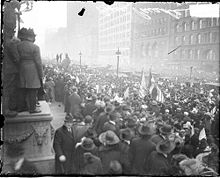 Armistice Day parade 1918
Armistice Day parade 1918
The district has changed over the years as various architectural designs have evolved to compliment it. The boulevard was widened between 1909 and 1910 causing the Art Institute of Chicago Building to have to move the lions guarding its entrance back 12 feet.[10] At that time, the Jackson Boulevard and Michigan Avenue intersection (the end of route 66) was known as "route center".[11] Also at that time, the boulevard had no streets crossing it and extending eastward, and thus, the Jackson intersection was a T intersection. This was still true in 1920 when the Michigan Avenue Bridge opened and increased traffic by connecting this boulevard with the Magnificent Mile and the community north of the Chicago River a quarter mile to the north of this district.[11] The Fountain of the Great Lakes (installed in 1913) was highly visible from route center.[11] Today, four streets cross Michigan Avenue within the district (in addition to its northern and southern endpoints at crossing streets). Three of the four change names as they cross Michigan: eastbound East Monroe Street (100 south) becomes East Monroe Drive; eastbound East Jackson Boulevard (300 south) becomes East Jackson Drive; and two-way East Congress Parkway (500 south) becomes East Congress Drive as it crosses into Grant Park to the east.[12] East Balbo Drive (700 south) does not change names as it crosses Michigan.[12]
Today
Today the only building on the eastern side of Michigan Avenue in the Historic District hosts the Art Institute of Chicago. However, several interesting structures have been added to the northern part of the eastern side of Michigan Avenue in Millennium Park such as Crown Fountain and McCormick Tribune Plaza. The current "End Historic US 66" marker is now located along Michigan Avenue in this district to mark the official end of U.S. Route 66 in Illinois, but this and several others transverse Michigan Avenue within Grant Park because landfill has created two blocks of real estate between Michigan Avenue and the Lake Michigan shoreline. Also, the Fountain was relocated and is no longer easily seen from Michigan Avenue.
Among the current issues today is the trend to redevelop properties by constructing grand towers behind the facades of historic structures along Michigan and Wabash Avenues (the parallel street one block to the west). The most recent examples of this have been The Heritage at Millennium Park, Legacy at Millennium Park and the 80-story tower proposed as part of the YWCA building redevelopment at 830 S. Michigan Avenue. This trend is now endangering the Chicago Athletic Association Annex, which has been proposed for demolition to make way for a fifty- to eighty-story condominium tower across from Millennium Park.[13] As a result, the building is listed first on the 2006-07 Chicagoland Watch List of the Landmarks Preservation Council of Illinois.[14] On the other hand many were concerned that the landmark district designation would stagnate development of the area.[15] The purpose of the designation was to "keep the architecture there and encourage architecture like it and keep the wall of the park," according to the City's Department of Planning and Development. Thus, redevolpment for new uses will be part of the ongoing concerns for the neighborhood. Thus, buildings being renovated for condos and dormitories is a part of the present and future for the district.[15]
Buildings in the District
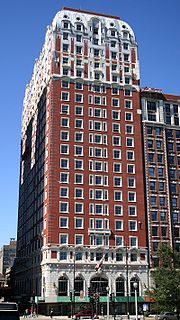 The Blackstone Hotel has hosted almost every 20th century U.S. President.
The Blackstone Hotel has hosted almost every 20th century U.S. President.
 The Auditorium Building was the first home of the Chicago Civic Opera and the Chicago Symphony Orchestra.
The Auditorium Building was the first home of the Chicago Civic Opera and the Chicago Symphony Orchestra.
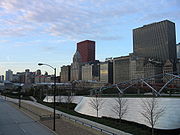 view from BP Pedestrian Bridge overpass
view from BP Pedestrian Bridge overpass
Several of the buildings listed below have played a prominent role in the cultural history of Chicago.
The Blackstone has become part of Chicago's history as the city that has hosted more United States presidential nominating conventions (26) than any other two American cities,[16] The Blackstone Hotel has hosted almost every 20th century U.S. President,[17] and it has contributed the phrase “in a smoke-filled room" to American political parlance.[18][19]
The Chicago Symphony Orchestra debuted on October 16, 1891 and made its home in the Auditorium Theatre until moving to Orchestra Hall in 1904. Theodore Roosevelt gave his famous Bull Moose speech in 1912 at the Auditorium and was nominated for President of the United States by the independent National Progressive Party. The Auditorium has hosted Jimi Hendrix, The Who, The Grateful Dead, and many others. The Auditorium Building is considered a milestone in the development of modern architecture.[20]
The Chicago Cultural Center serves as the city's official reception venue where the Mayor of Chicago has welcomed Presidents and royalty, diplomats and community leaders. According to Crain's Chicago Business, the Chicago Cultural Center was the eighth most-visited cultural institution in the Chicago area in 2004, with 767,000 visitors. The interior includes ornate mosaics, marbles, bronze, and stained-glass domes designed by the Tiffany Glass and Decorating Company.[21]
The Art Institute of Chicago is a fine art museum well known for its Impressionist and American art.
Name[4] Street Address Architect Status Willoughby Tower 8 S. Michigan Avenue Samuel N. Crowen & Associates[22] Metropolitan Tower (formerly Straus Building) 310 S. Michigan Avenue Graham, Anderson, Probst & White[23] Chicago Hilton & Towers 720 S. Michigan Avenue Holabird & Roche[24] Buckingham Building
(a.k.a. Socony-Vacuum Building)59-67 E. Van Buren Street Holabird & Root LLC[25] NRHP[26] Borg-Warner Building 200 S. Michigan Avenue A. Epstein and Sons International, Inc., George A. Fuller Company[27] Michigan Boulevard Building 30 N. Michigan Avenue Jarvis Hunt[28] 6 North Michigan
(a.k.a. Montgomery Ward Building)6 N. Michigan Avenue Holabird & Roche, Schmidt, Garden & Martin[29] The Blackstone 636 S. Michigan Avenue Marshall & Fox[30] CL, NRHP McCormick Building 332 S. Michigan Avenue Holabird & Roche[31] Michigan Avenue Lofts 910 S. Michigan Avenue Graham, Anderson, Probst & White, Marshall & Fox[32] Peoples Gas Building 122 S. Michigan Avenue D.H. Burnham & Company[33] NRHP Chicago Athletic Association Annex 71 E. Madison Street Schmidt, Garden & Martin[34] Wolberg Hall 112 S. Michigan Avenue Barnett, Haynes & Barnett, Swann & Weiskopf[35] Lake View Building 116 S. Michigan Avenue Jenney, Mundie & Jensen[36] NRHP Santa Fe Building (formerly Railway Exchange Building)[37] 224 S. Michigan Avenue D.H. Burnham & Company[38] NRHP Auditorium Building 430 S. Michigan Avenue Adler & Sullivan[39] CL, NHL, NRHP The Boulevard 104 S. Michigan Avenue Holabird & Roche[40] Columbia College Chicago Christian A. Eckstorm[41] Torco Building 624 S. Michigan Avenue Christian A. Eckstorm, Alfred S. Alschuler[42] Essex Inn 800 S. Michigan Avenue A. Epstein and Sons International, Inc.[43] The University Club of Chicago 76 E. Monroe Street Holabird & Roche[44] Congress Hotel Addition 520 S. Michigan Avenue Holabird & Roche[45] 888 South Michigan 888 S. Michigan Avenue Holabird & Roche[46] Gage Building 18 S. Michigan Avenue Louis H. Sullivan, Holabird & Roche[47] CL, NRHP Fine Arts Building 410 S. Michigan Avenue Solon S. Beman[48] CL, NRHP Crane Company Building 836 S. Michigan Avenue Holabird and Roche NRHP Statuses
- CL-Chicago Landmark
- NHL-National Historic Landmark
- NRHP-National Register of Historic Places
Other buildings include the Fine Arts Building (CL, NRHP), the Chicago Cultural Center (CL, NRHP) and the Art Institute of Chicago.
Notes
- ^ a b c "Historic Michigan Boulevard District". City of Chicago Department of Planning and Development, Landmarks Division. 2003. http://webapps.cityofchicago.org/LandmarksWeb//districtDetail.do?disID=12. Retrieved 2007-05-31.
- ^ Hayner, Don and Tom McNamee, Streetwise Chicago, Loyola University Press, 1988, ISBN 0-8294-0597-6.
- ^ Emporis claims this district extends to Randolph street which is 1200 South.
- ^ a b "Michigan Avenue Landmark District". Emporis. 2007. http://www.emporis.com/en/wm/zo/?id=100014. Retrieved 2007-05-31.
- ^ Hayner and McNamee, Streetwise Chicago, "Michigan Avenue", p. 87.
- ^ "Grant Park". Electronic Encyclopedia of Chicago. Chicago Historical Society. 2005. http://www.encyclopedia.chicagohistory.org/pages/538.html. Retrieved 2007-06-02.
- ^ Sinkevitch, Alice, "AIA Guide to Chicago" (2nd edition),, p. 14 2004, Harcourt Books, ISBN 0-15-602908-1.
- ^ a b "Boul Mich Tour". City of Chicago Department of Planning and Development, Landmarks Division. 2003. http://www.ci.chi.il.us/Landmarks/Tours/BoulMich.html. Retrieved 2007-05-31.
- ^ Stamper, John M., "Chicago's North Michigan Avenue," University of Chicago Press, 1991, p. ix, ISBN 0-226-77085-0.
- ^ "The Art Institute of Chicago Museum Studies'" Volume 14, no. 1, 1988, The Art Institute of Chicago, p. 8, ISBN 0-226-02813-5
- ^ a b c "Route Center: Jackson and Michigan Boulevards Circa 1907-1923". David G. Clark. 2004. http://windycityroadwarrior.com/Stories/mich-jcksn-1914.htm. Retrieved 2007-06-07.
- ^ a b "500 S Michigan Ave Chicago, IL 60605". Google - Maps Data/ NAVTEQ. http://maps.google.com/maps?f=q&hl=en&geocode=&q=500+S+Michigan+Ave,+Chicago,+Cook,+Illinois+60601,+United+States&sll=41.875664,-87.624378&sspn=0.010321,0.028667&ie=UTF8&ll=41.875664,-87.624378&spn=0.020643,0.057335&z=15. Retrieved 2008-04-29.
- ^ "Chicago Athletic Association Building and Annex". Landmarks Illinois. 2007. http://www.landmarks.org/chicago_watch_2006_1.htm. Retrieved 2007-05-31.
- ^ "Chicagoland Watch List 2006-07". Landmarks Illinois. 2007. http://www.landmarks.org/chicago_watch.htm. Retrieved 2007-05-31.
- ^ a b Carlton, Hayley. "Grant Park street wall, surrounding buildings examined at GPAC meeting". nearwestgazette.com. http://www.nearwestgazette.com/Archive/2008/0308/News0308e.htm. Retrieved 2008-04-07.
- ^ Sautter, R. Craig (2005). "Political Conventions". The Electronic Encyclopedia of Chicago. Chicago Historical Society. http://www.encyclopedia.chicagohistory.org/pages/986.html. Retrieved 2007-03-28.
- ^ Allegrini, Robert V., Chicago's Grand Hotels, 2005, Arcadia Publishing, p.92.
- ^ Wolfe, Gerard R., Chicago In and Around the Loop: Walking Tours of Architecture and History, 1996, McGraw-Hill, p.176.
- ^ "Smoke-Filled Room". Electronic Encyclopedia of Chicago. Chicago Historical Society. 2005. http://www.encyclopedia.chicagohistory.org/pages/3217.html. Retrieved 2007-05-27.
- ^ "Auditorium Building". City of Chicago Department of Planning and Development, Landmarks Division. 2003. http://www.ci.chi.il.us/Landmarks/A/Auditorium.html. Retrieved 2007-07-16.
- ^ "Chicago Public Library/Cultural Center". City of Chicago Department of Planning and Development, Landmarks Division. 2003. http://www.ci.chi.il.us/Landmarks/C/CulturalCenter.html. Retrieved 2007-07-16.
- ^ "Willoughby Tower". Emporis. 2007. http://www.emporis.com/en/wm/bu/?id=willoughbytower-chicago-il-usa. Retrieved 2007-05-31.
- ^ "Metropolitan Tower". Emporis. 2007. http://www.emporis.com/en/wm/bu/?id=metropolitantower-chicago-il-usa. Retrieved 2007-05-31.
- ^ "Chicago Hilton & Towers". Emporis. 2007. http://www.emporis.com/en/wm/bu/?id=chicagohiltontowers-chicago-il-usa. Retrieved 2007-05-31.
- ^ "Socony-Vacuum Building". Emporis. 2007. http://www.emporis.com/en/wm/bu/?id=soconyvacuumbuilding-chicago-il-usa. Retrieved 2007-05-31.
- ^ "ILLINOIS - Cook County". www.nationalregisterofhistoricalplaces.com. http://www.historicdistricts.com/IL/Cook/state.html. Retrieved 2007-07-11.
- ^ "Borg-Warner Building". Emporis. 2007. http://www.emporis.com/en/wm/bu/?id=borgwarnerbuilding-chicago-il-usa. Retrieved 2007-05-31.
- ^ "Michigan Boulevard Building". Emporis. 2007. http://www.emporis.com/en/wm/bu/?id=michiganboulevardbuilding-chicago-il-usa. Retrieved 2007-05-31.
- ^ "6 North Michigan". Emporis. 2007. http://www.emporis.com/en/wm/bu/?id=6northmichigan-chicago-il-usa. Retrieved 2008-06-01.
- ^ "The Blackstone". Emporis. 2007. http://www.emporis.com/en/wm/bu/?id=streetblackst1-chicago-il-usa. Retrieved 2007-05-31.
- ^ "McCormick Building". Emporis. 2007. http://www.emporis.com/en/wm/bu/?id=mccormickbuilding-chicago-il-usa. Retrieved 2007-05-31.
- ^ "Michigan Avenue Lofts". Emporis. 2007. http://www.emporis.com/en/wm/bu/?id=michiganavenuenuelofts-chicago-il-usa. Retrieved 2007-05-31.
- ^ "People's Gas Building". Emporis. 2007. http://www.emporis.com/en/wm/bu/?id=peoplesgasbuilding-chicago-il-usa. Retrieved 2007-05-31.
- ^ "Chicago Athletic Association Annex". Emporis. 2007. http://www.emporis.com/en/wm/bu/?id=chicagoathleticassociationannex-chicago-il-usa. Retrieved 2007-05-31.
- ^ "Wolberg Hall". Emporis. 2007. http://www.emporis.com/en/wm/bu/?id=wolberghall-chicago-il-usa. Retrieved 2007-05-31.
- ^ "Lake View Building". Emporis. 2007. http://www.emporis.com/en/wm/bu/?id=lakeviewbuilding-chicago-il-usa. Retrieved 2007-05-31.
- ^ "Santa Fe Building from Grant Park, 2004". Electronic Encyclopedia of Chicago. Chicago Historical Society. 2005. http://www.encyclopedia.chicagohistory.org/pages/10925.html. Retrieved 2007-05-31.
- ^ "Santa Fe Building". Emporis. 2007. http://www.emporis.com/en/wm/bu/?id=santafebuilding-chicago-il-usa. Retrieved 2007-05-31.
- ^ "Auditorium Building". Emporis. 2007. http://www.emporis.com/en/wm/bu/?id=auditoriumstreetater-chicago-il-usa. Retrieved 2007-05-31.
- ^ "The Boulevard". Emporis. 2007. http://www.emporis.com/en/wm/bu/?id=streetboulevard-chicago-il-usa. Retrieved 2007-05-31.
- ^ "Columbia College". Emporis. 2007. http://www.emporis.com/en/wm/bu/?id=columbiacollege-chicago-il-usa. Retrieved 2007-05-31.
- ^ "Torco Building". Emporis. 2007. http://www.emporis.com/en/wm/bu/?id=torcobuilding-chicago-il-usa. Retrieved 2007-05-31.
- ^ "Essex Inn". Emporis. 2007. http://www.emporis.com/en/wm/bu/?id=essexinn-chicago-il-usa. Retrieved 2007-05-31.
- ^ "University Club". Emporis. 2007. http://www.emporis.com/en/wm/bu/?id=universityclub-chicago-il-usa. Retrieved 2007-05-31.
- ^ "Congress Hotel Addition". Emporis. 2007. http://www.emporis.com/en/wm/bu/?id=congresshoteladdition-chicago-il-usa. Retrieved 2007-05-31.
- ^ "888 South Michigan". Emporis. 2007. http://www.emporis.com/en/wm/bu/?id=888southmichigan-chicago-il-usa. Retrieved 2007-05-31.
- ^ "Gage Building". Emporis. 2007. http://www.emporis.com/en/wm/bu/?id=gagebuilding-chicago-il-usa. Retrieved 2007-05-31.
- ^ "Fine Arts Building". Emporis. 2007. http://www.emporis.com/en/wm/bu/?id=fineartsbuilding-chicago-il-usa. Retrieved 2008-07-03.
City of Chicago Architecture · Beaches · Climate · Colleges and Universities · Community areas · Culture · Demographics · Economy · Flag · Freeways · Geography · Government · History · Landmarks · Literature · Media · Music · Neighborhoods · Parks · Public schools · Skyscrapers · Sports · Theatre · Transportation
 Category ·
Category ·  Portal
PortalGrant Park Features and attractions Art Institute of Chicago • BP Pedestrian Bridge • Buckingham Fountain • Burnham Pavilions • Chicago Lakefront Trail • Grant Park Symphony Orchestra • Lake Michigan • Millennium Park • Monroe Harbor • Museum Campus • Nichols Bridgeway • Petrillo Music Shell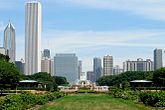
Public art Agora • Cloud Gate • Columbus Monument • Crown Fountain • The Bowman and The Spearman • Fountain of the Great Lakes • Fountain of the Tritons • Large Interior Form • Lincoln Monument • Man Enters the CosmosEvents Area streets Balbo Drive • Columbus Drive • Congress Parkway • Historic Michigan Boulevard District • Jackson Boulevard • Lake Shore Drive • Michigan Avenue • Monroe Street • Randolph Street • Roosevelt RoadOther Categories:- Historic districts in Chicago, Illinois
- Landmarks in Chicago, Illinois
- Chicago school (architecture)
Wikimedia Foundation. 2010.


